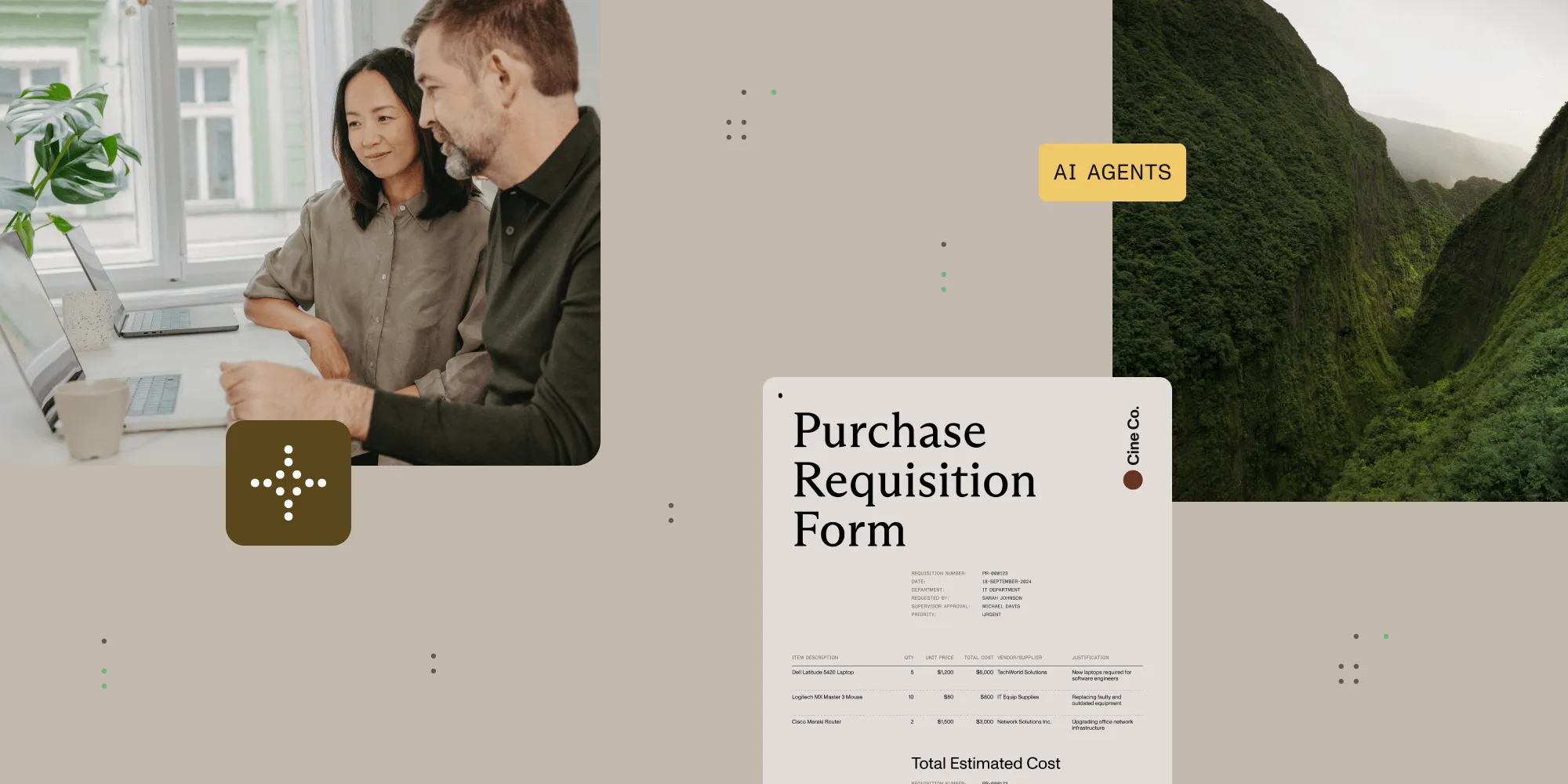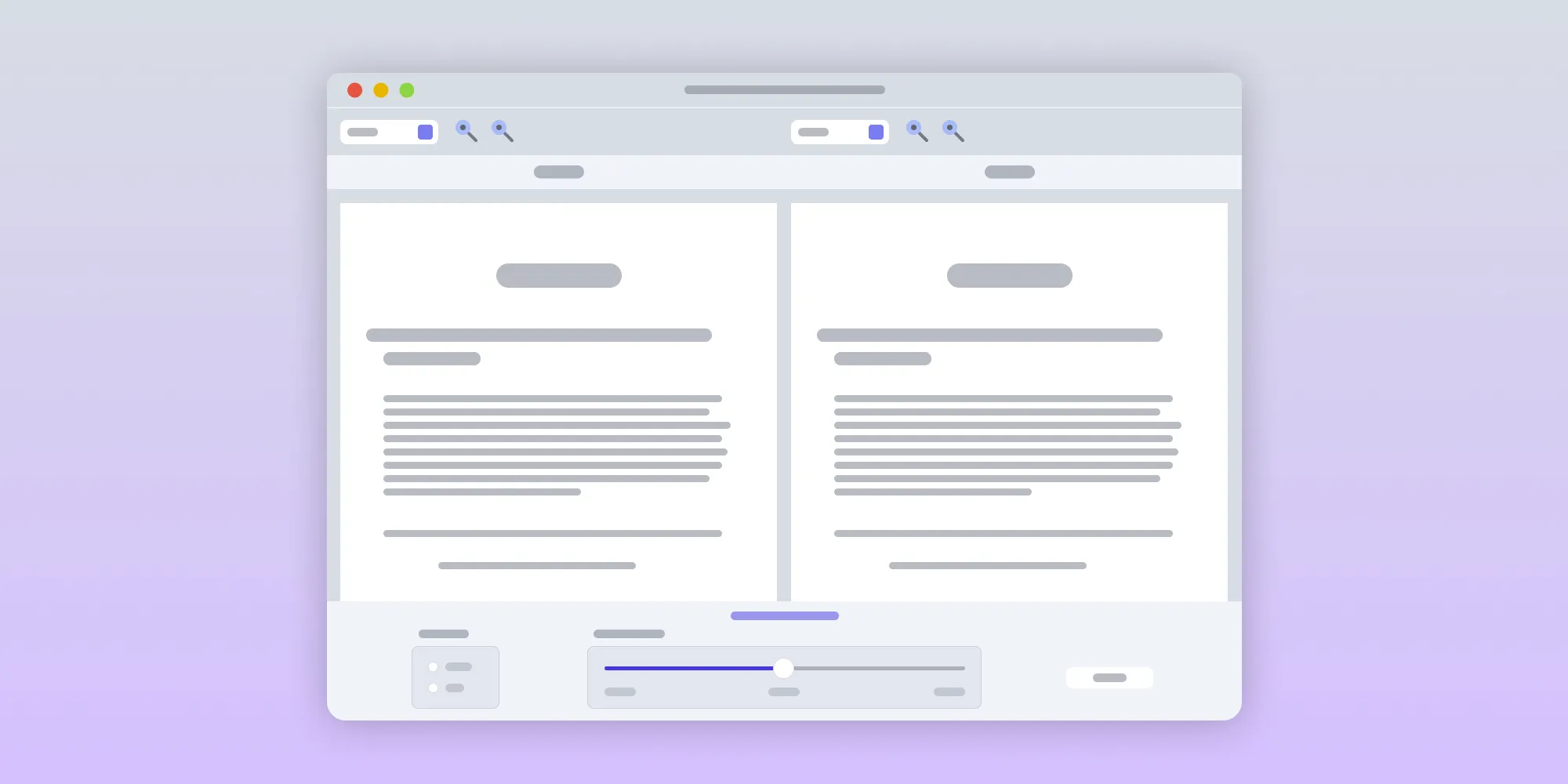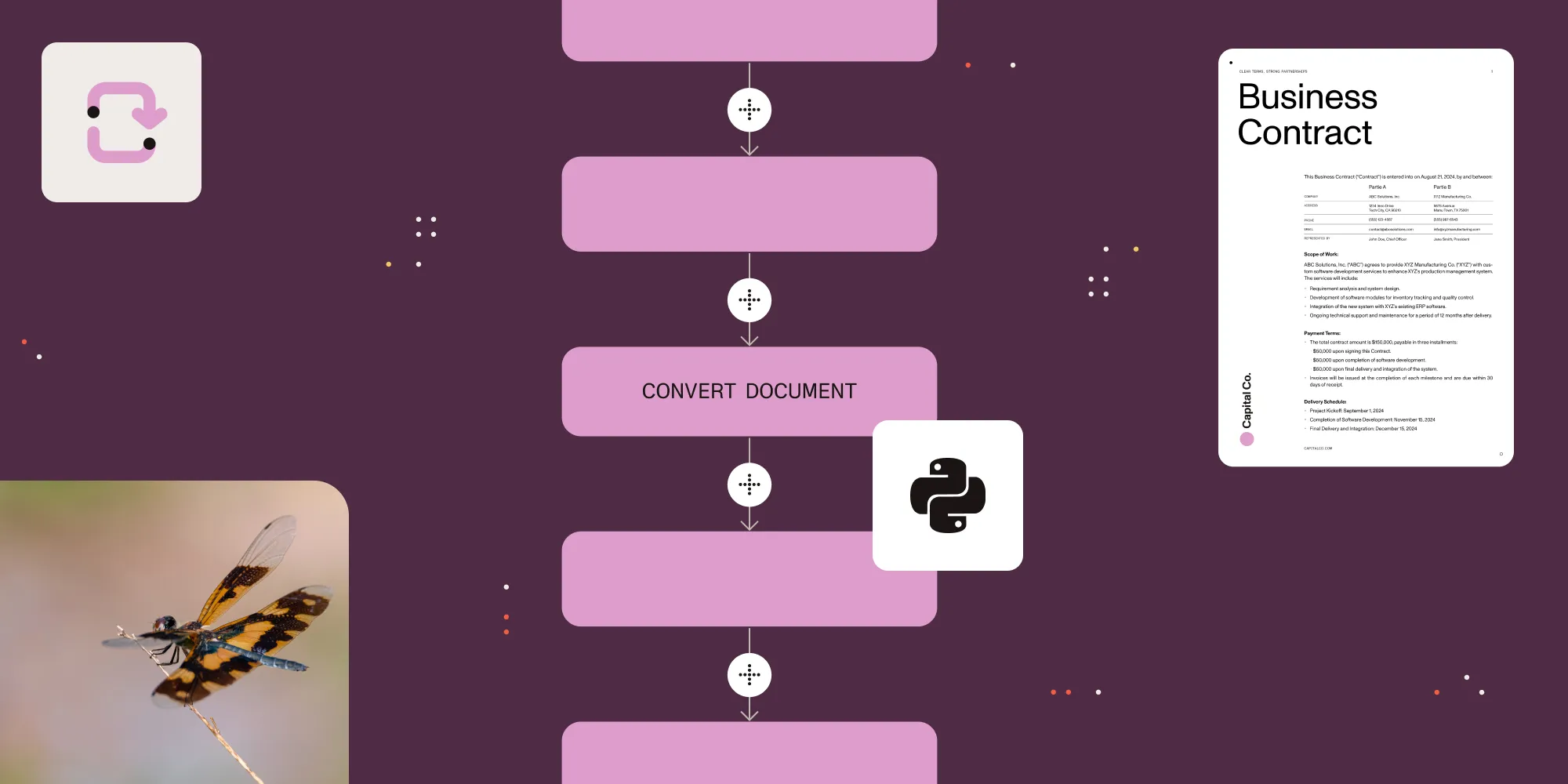PDF-to-Word conversion: Complete guide to tools and solutions
Table of contents

- Understand why converting PDF to Word is technically complex (and where tools fail).
- Compare popular open source tools: pdf2docx, PyMuPDF + python-docx, PDF.js + docx, and LibreOffice + unoconv.
- Explore Nutrient’s commercial SDKs and API for high-fidelity, OCR-enabled conversion.
- See hands-on code examples for Python, JavaScript, C#, and REST API.
- Get practical guidance on choosing the right approach for your documents, team, and budget.
This guide examines various approaches to PDF-to-Word conversion — from open source libraries to commercial solutions — helping you understand the tradeoffs and choose the right tool for your specific requirements.
The real cost of broken PDF conversion
Before diving into the solutions, this post will first cover what’s actually at stake when document conversion goes wrong.
What happens when conversion fails
You upload a PDF expecting a clean Word document, but instead you get:
- Tables converted into a grid of misaligned text boxes
- Page headers mixed into the body text
- Lists turned into disconnected lines without bullets or numbering
- Fonts replaced inconsistently, breaking your layout
- Images misplaced or missing entirely
These kinds of problems aren’t just frustrating. They can cost real time and credibility:
- Hours lost manually reformatting documents just to make them usable
- Delays when critical reports need last-minute fixes
- Confusion when structure and meaning change (e.g. contract clauses)
- Reduced productivity when teams avoid editing converted documents altogether
Why PDF-to-Word conversion is genuinely difficult
The fundamental challenge isn’t technical complexity. It’s that PDF and Word represent documents in completely different ways:
- PDF — “Draw this text at pixel position X,Y with font Z at size 12pt.”
- Word — “This is a heading, followed by a paragraph, with a table below.”
Converting between these paradigms requires sophisticated algorithms that can:
- Reconstruct document structure from visual positioning
- Preserve complex layouts while enabling text editing
- Handle font substitution intelligently
- Maintain table relationships across page breaks
- Process embedded graphics without quality loss
Most open source tools break down with real-world documents because they focus on visual extraction, not logical reconstruction. That’s where commercial options like Nutrient shine.
Open source PDF conversion solutions
Open source libraries are appealing when you’re building on a tight budget or just need a quick solution. But converting PDFs to editable Word documents is a nuanced task, especially when layout fidelity, formatting, and structure matter.
The next section will break down the most popular open source tools used for PDF-to-Word conversion, with pros, cons, and guidance on where they fit best.
pdf2docx: Purpose-built PDF-to-DOCX conversion
pdf2docx(opens in a new tab) is an open source Python tool for converting PDF to DOCX, using MuPDF (via PyMuPDF) to extract content and python-docx to write Word files. It reconstructs layout intelligently by grouping text, detecting tables, and preserving styles.
Strengths
- Purpose-built for PDF-to-DOCX conversion using MuPDF and
python-docx. - Best-in-class formatting fidelity among open source tools.
- Produces highly editable outputs: real paragraphs, tables, and preserved styles.
- Handles basic text documents and simple layouts effectively.
- Supports password-protected PDFs.
- Cross-platform: runs on Windows, macOS, and Linux.
- Offers both a Python library and CLI, with a basic GUI available.
- Easy to integrate into scripts, pipelines, or services.
- Multiprocessing supported for better performance on large batches.
- Actively maintained and backed by Artifex.
- Free and open source under AGPL.
Weaknesses
- No built-in OCR: scanned PDFs require external OCR tools (e.g. Tesseract).
- Complex layouts (e.g. multicolumn, decorative elements) may not convert cleanly.
- Doesn’t map PDF headers/footers to native Word headers/footers.
- Limited support for vector graphics and charts.
- Font rendering depends on system fonts being available.
- Complex tables may lose structure or formatting.
- Moderate speed on large files due to Python-based DOCX generation.
- Memory usage increases with large images or documents.
- No standalone installer: requires Python environment and
pip install. - AGPL license may restrict use in proprietary software without a commercial license.
- Possible compatibility issues with newer Python versions.
Best suited for
Simple text documents, basic reports, and scenarios where perfect formatting preservation isn’t critical.
Installation
pip install pdf2docxBasic usage
from pdf2docx import Converter
def convert_pdf_to_word(pdf_path, docx_path): """Convert PDF to DOCX using pdf2docx""" cv = Converter(pdf_path) cv.convert(docx_path) cv.close() print(f"Converted {pdf_path} to {docx_path}")
# Example usageconvert_pdf_to_word('input.pdf', 'output.docx')Advanced configuration
from pdf2docx import Converter
def advanced_pdf_conversion(pdf_path, docx_path): """Advanced PDF to DOCX conversion with custom settings""" cv = Converter(pdf_path) cv.convert( docx_path, start=0, # Start page (0-indexed) end=None, # End page (None for all pages) pages=None, # Specific pages list password=None, # PDF password if protected multi_processing=True, # Enable multi-processing cpu_count=4 # Number of CPU cores to use ) cv.close()
advanced_pdf_conversion('complex.pdf', 'output.docx')PyMuPDF + python-docx: Custom conversion pipeline
PyMuPDF + python-docx is a DIY approach that pairs PyMuPDF(opens in a new tab) (a Python wrapper around the MuPDF engine) for PDF parsing with python-docx(opens in a new tab) for Word creation. You write the logic that turns raw PDF glyphs into Word paragraphs, lists, and tables.
Strengths
- Full control over layout, paragraph grouping, and formatting.
- Can be extended to detect styles and layout cues or add metadata.
- Ideal for custom workflows where you want to post-process or tag content.
Weaknesses
- You’re essentially rebuilding a PDF parser and Word writer.
- Reconstructing accurate flow from visual cues (X/Y coordinates) is non-trivial.
- Requires deep logic to detect lists, headers, and tables.
- Doesn’t come with OCR or advanced layout preservation.
Best suited for
- Projects needing fine-tuned conversion logic (e.g. extracting specific elements from PDFs).
- Teams building internal tools where flexibility is more important than speed.
- Developers who enjoy building custom solutions (and have the time to maintain them).
Usage
import fitz # PyMuPDFfrom docx import Documentfrom docx.shared import Inches, Ptfrom docx.enum.text import WD_ALIGN_PARAGRAPH
def extract_pdf_content(pdf_path):78 collapsed lines
"""Extract text and images from PDF using PyMuPDF""" doc = fitz.open(pdf_path) content = []
for page_num in range(doc.page_count): page = doc[page_num]
# Extract text blocks with formatting info blocks = page.get_text("dict")
for block in blocks["blocks"]: if "lines" in block: # Text block for line in block["lines"]: for span in line["spans"]: content.append({ 'type': 'text', 'text': span["text"], 'font': span["font"], 'size': span["size"], 'flags': span["flags"], # Bold, italic, etc. 'bbox': span["bbox"] # Position }) else: # Image block content.append({ 'type': 'image', 'bbox': block["bbox"] })
doc.close() return content
def create_word_document(content, output_path): """Create Word document from extracted content""" doc = Document()
current_paragraph = None
for item in content: if item['type'] == 'text': text = item['text'].strip() if not text: continue
# Create new paragraph if needed if current_paragraph is None: current_paragraph = doc.add_paragraph()
# Add text run with formatting run = current_paragraph.add_run(text)
# Apply formatting based on PDF flags if item['flags'] & 2**4: # Bold flag run.font.bold = True if item['flags'] & 2**1: # Italic flag run.font.italic = True
# Set font size run.font.size = Pt(item['size'])
# Check if this should start a new paragraph # (simplified logic - you might need more sophisticated detection) if text.endswith('.') or text.endswith('\n'): current_paragraph = None
doc.save(output_path)
def pdf_to_word_custom(pdf_path, docx_path): """Complete PDF to Word conversion pipeline""" print(f"Extracting content from {pdf_path}...") content = extract_pdf_content(pdf_path)
print(f"Creating Word document at {docx_path}...") create_word_document(content, docx_path)
print("Conversion completed!")
# Example usagepdf_to_word_custom('input.pdf', 'custom_output.docx')PDF.js + docx: Web-compatible solution
PDF.js(opens in a new tab) + docx(opens in a new tab) is a browser-friendly pipeline that uses PDF.js to parse PDF content and the docx library to assemble a Word file. It’s ideal for when you need client-side or serverless conversion without Python or native binaries.
Strengths
- Runs in JavaScript. Great for Web environments or Node.js.
- Lets you convert PDFs in-browser (or on a server) without Python or native libraries.
- Provides full control over output structure. You decide how to group, style, and render content.
Weaknesses
- Requires significant development to turn raw data into structured DOCX files.
- No built-in formatting intelligence (e.g. detecting headings, tables, etc.).
- Performance can lag with large PDFs or complex layouts.
- No OCR support for scanned PDFs.
Best suited for
- Web apps or lightweight browser extensions.
- Developers needing custom logic for PDF content extraction and formatting.
- Simple PDFs (like generated invoices, reports) where formatting is predictable.
Usage
const fs = require("fs");const { Document, Packer, Paragraph, TextRun } = require("docx");const pdfjsLib = require("pdfjs-dist");
async function extractTextFromPDF(pdfPath) {90 collapsed lines
const data = new Uint8Array(fs.readFileSync(pdfPath)); const pdf = await pdfjsLib.getDocument({ data }).promise;
let fullText = [];
for (let i = 1; i <= pdf.numPages; i++) { const page = await pdf.getPage(i); const content = await page.getTextContent();
const pageText = content.items.map((item) => ({ text: item.str, x: item.transform[4], y: item.transform[5], width: item.width, height: item.height, fontName: item.fontName, }));
fullText.push(...pageText); }
return fullText;}
function createWordDocument(textItems) { const paragraphs = []; let currentParagraph = []; let lastY = null;
// Group text items into paragraphs based on Y position textItems.forEach((item) => { if (lastY !== null && Math.abs(item.y - lastY) > 10) { // New paragraph detected if (currentParagraph.length > 0) { paragraphs.push(currentParagraph); currentParagraph = []; } }
currentParagraph.push(item); lastY = item.y; });
// Add the last paragraph if (currentParagraph.length > 0) { paragraphs.push(currentParagraph); }
// Create DOCX paragraphs const docxParagraphs = paragraphs.map((paragraph) => { const runs = paragraph.map( (item) => new TextRun({ text: item.text, // You can add more formatting based on fontName, size, etc. }), );
return new Paragraph({ children: runs, }); });
return new Document({ sections: [ { properties: {}, children: docxParagraphs, }, ], });}
async function convertPDFToWord(inputPath, outputPath) { try { console.log("Extracting text from PDF..."); const textItems = await extractTextFromPDF(inputPath);
console.log("Creating Word document..."); const doc = createWordDocument(textItems);
console.log("Saving Word document..."); const buffer = await Packer.toBuffer(doc); fs.writeFileSync(outputPath, buffer);
console.log(`Conversion completed: ${outputPath}`); } catch (error) { console.error("Conversion failed:", error); }}
// Example usageconvertPDFToWord("input.pdf", "output.docx");LibreOffice Writer + Unoconv (open source)
LibreOffice(opens in a new tab) is a free office suite that can open PDFs (via Draw) and save them as DOCX files. Unoconv(opens in a new tab) is a command-line tool that automates these conversions using LibreOffice’s UNO API. This combination represents a typical open source method for PDF-to-DOCX conversion.
Strengths
- Free and open source, with no limitations on usage. Easily available on all major platforms.
- Can handle basic conversions: For text-centric PDFs, you might get an editable result that at least preserves paragraphs (though this is hit-or-miss).
- Supports batch operation via Unoconv or headless mode (scriptable, albeit with caveats).
- Leverages a full Office suite. In theory, complex elements (charts, forms) are at least recognized (e.g. form fields might come through, but as non-editable annotations).
- Constantly improving: The community does work on PDF importing (as seen with the text box consolidation feature).
Weaknesses
- Low conversion fidelity for layout. It uses many absolutely positioned text boxes, leading to an output that’s difficult to edit.
- Unreliable for many PDFs: It often fails or produces errors, especially for multipage PDFs (older version had bugs where only one page converted, etc.).
- Performance is relatively slow and resource-heavy; automating it is non-trivial.
- No built-in OCR; scanned PDFs won’t be turned into text.
- Essentially not intended as a PDF-to-Word tool, so using it feels like forcing a round peg into a square hole (you might spend a lot of time cleaning up results).
Best suited for
- One-off conversions of very simple PDFs (e.g. plain text).
- Low-risk internal use when you can tolerate cleanup.
- Environments where LibreOffice is already installed and you want basic automation.
Commercial solutions: Why they outperform open source tools
When real-world business documents are on the line, commercial PDF-to-Word converters offer:
- Reliable formatting accuracy for tables, lists, headers, and multicolumn layouts.
- Consistent output across large batches of diverse PDFs.
- Built-in OCR to handle scanned documents seamlessly.
- Enterprise features like API access, batch conversion, and cross-platform SDKs.
- Commercial-grade support, documentation, and SLA options.
Unlike open source libraries that require workarounds, commercial tools are purpose-built for high-fidelity conversion, especially for regulated, customer-facing, or time-sensitive use cases.
Nutrient’s approach to PDF conversion
Nutrient offers browser and server-side SDKs optimized for:
- Precise layout preservation (even for forms, legal documents, and reports).
- Fully editable output in DOCX.
- Native support for images, fonts, tables, and charts.
- Optional OCR engine (multi-language, high accuracy).
- Seamless integration into .NET, web, and API-based applications.
This makes it a practical upgrade for teams struggling with PDF conversion in Python or LibreOffice, especially when dealing with contracts, HR forms, reports, or multi-language documents.
Nutrient provides several solutions optimized for different use cases, from client-side browser conversion to server-side API processing.
Open source characteristics
- Community-driven development
- Cost-effective for simple use cases
- Varying levels of documentation
- Self-support model
- Suitable for basic conversion needs
Nutrient’s commercial approach
- Professional development team
- Optimized for complex business documents
- Comprehensive documentation and examples
- Commercial support and SLA options
- Enterprise-grade reliability and features
Nutrient .NET SDK (formerly GdPicture.NET)
Nutrient .NET SDK is a native, commercial library for high-fidelity PDF-to-Word, Excel, and PowerPoint conversion. No Office or LibreOffice is needed. With one method (SaveAsDOCX), it preserves complex layouts, styling, forms, and even embedded charts. It handles batch processing; runs on Windows, Linux, and macOS; and uses multithreading for speed.
The SDK integrates easily into any .NET app and requires no external dependencies. Pair it with Nutrient’s OCR module to convert scanned PDFs into searchable, editable Word files. Most documents convert cleanly; only rare graphic edge cases may need touch-up.
Pros
- Near-perfect layout and formatting fidelity
- Fast, native performance with batch support
- No Office/LibreOffice dependency
- Broad .NET platform support
- Advanced OCR module available
- Commercial-grade support and documentation
Cons
- Requires a paid license
- Not a standalone end user tool; must be integrated
- Edge cases may require post-conversion touch-up
- .NET-only — wrapping is needed for non-.NET environments
Basic PDF-to-Word conversion
using GdPictureDocumentConverter converter = new();GdPictureStatus status = converter.LoadFromFile("input.pdf");if (status != GdPictureStatus.OK){ throw new Exception(status.ToString());}
status = converter.SaveAsDOCX("output.docx");if (status != GdPictureStatus.OK){ throw new Exception(status.ToString());}
Console.WriteLine("The input document has been converted to a docx file");Nutrient Web SDK (client-side JavaScript)
Nutrient Web SDK brings PDF-to-Office conversion to the browser using WebAssembly. It runs fully client-side, so users can convert PDFs to Word, Excel, or PowerPoint without any server interaction.
The SDK delivers high-fidelity layouts, fonts, tables, and images that are preserved much like the .NET version. For example, teachers using a SaaS portal could convert and edit PDFs directly in the browser without reformatting.
Pros
- Fully browser-based; no server or upload required
- High-fidelity conversion (layout, fonts, tables)
- Great user experience on modern devices
- Works with major JS frameworks
- View and convert Office and PDF formats
- No third-party services needed
Cons
- Speed depends on the user’s device
- Larger WASM bundle (adds MBs to app)
- Not for headless/server-side automation
- Requires commercial license
- Limited OCR without extra tooling
Installation
To get started with Nutrient Web SDK, install it via npm:
npm install @nutrient-sdk/viewerOr, include it directly from a CDN:
<script src="https://cdn.cloud.pspdfkit.com/pspdfkit-web@1.0.0/nutrient-viewer.js"></script>Browser-based PDF-to-Word conversion
Set up your HTML with a fullscreen container for the viewer:
<div id="nutrient" style="width: 100%; height: 100vh;"></div><script src="index.js"></script>Then add the conversion logic in index.js:
window.NutrientViewer.load({ container: "#nutrient", document: "source.pdf",}) .then((instance) => instance.exportOffice({ format: "docx", }), ) .then(function (buffer) { const blob = new Blob([buffer], { type: "application/vnd.openxmlformats-officedocument.wordprocessingml.document", }); const objectUrl = window.URL.createObjectURL(blob); downloadDocument(objectUrl); window.URL.revokeObjectURL(objectUrl); });
function downloadDocument(blob) { const a = document.createElement("a"); a.href = blob; a.style.display = "none"; a.download = "output.docx"; a.setAttribute("download", "output.docx"); document.body.appendChild(a); a.click(); document.body.removeChild(a);}This script loads a PDF into the browser, converts it to DOCX using exportOffice, wraps the result in a Blob, and programmatically triggers the download of the file as output.docx.
Nutrient Document Web Services Processor API: Cloud-based PDF-to-Word conversion
For cloud-based applications or high-volume workloads, Nutrient’s Document Web Services (DWS) Processor API offers a secure, SOC 2-compliant REST API for converting PDF files to DOCX (and other formats) at scale. It’s designed for developers who need reliable, high-fidelity conversion without managing servers or installing SDKs.
API capabilities and features
Conversion features
- PDF to multiple Office formats (DOCX, XLSX, PPTX)
- Batch processing support
- OCR for scanned documents
- Advanced layout preservation algorithms
Integration benefits
- RESTful API for any programming language
- Cloud infrastructure (no server maintenance)
- Pay-per-use pricing model
- Comprehensive documentation and examples
Try It: Convert PDF to Word with the Nutrient API
Want to see it in action? Here’s a step-by-step example using Python and requests to convert a PDF to DOCX.
- Create a free account(opens in a new tab) to receive 200 free credits/month. Your API key will be available in the dashboard.
- Add a test PDF file named
input.pdfto your project directory. - Run the API call:
import requestsimport json
response = requests.request( 'POST', 'https://api.nutrient.io/build', headers = { 'Authorization': 'Bearer your_api_key_here' }, files = { 'file': open('input.pdf', 'rb') }, data = { 'instructions': json.dumps({ 'parts': [ { 'file': 'file' } ], 'output': { 'type': 'docx' } }) }, stream = True)
if response.ok: with open('result.docx', 'wb') as fd: for chunk in response.iter_content(chunk_size=8096): fd.write(chunk)else: print(response.text)This code will save the converted Word document as result.docx in your local directory.
Open result.docx to inspect the conversion result. It should preserve your PDF’s formatting, text, and tables.
Getting started fast
- Free trial — 200 credits/month included with your account
- No server required — All conversion happens in the cloud
- Language support — Use with Python, Java, JavaScript, C#, PHP, cURL, and more
- Security — SOC 2 Type 2 audited infrastructure
Prefer Postman? Start with our Postman collection(opens in a new tab).
Implementation best practices
For open source solutions
Open source libraries often require tuning and fallback logic. To improve results:
- Preprocess PDFs — Normalize content with Ghostscript or qpdf
- Manage fonts — Ensure fonts used in the PDF are installed and mapped
- Fallback strategies — Use multiple tools or pipelines based on PDF type
- Error handling — Build robust retry and error capture logic
- Test across variants — PDFs vary widely; even small visual differences can affect output
- Monitor performance — Log conversion times and success/failure rates
For commercial solutions
When adopting a commercial SDK or API:
- Test with your own documents — Don’t rely on marketing demos
- Plan for scale — Estimate document volume and concurrency
- Map out integration — Weigh the effort of API vs. SDK, and cloud vs. on-premises
- Evaluate support — Good documentation and SLA-backed support save time later
Choosing the right approach
Whether you go open source or commercial depends on budget, document complexity, and output expectations.
When to consider open source
- Simple, text-based PDFs with minimal layout
- You have development time but a limited budget
- Minor formatting issues are acceptable
- Lower document volume or frequency
When to consider commercial solutions
- High accuracy and layout fidelity are essential
- You’re processing contracts, reports, or forms
- You need batch conversion, OCR, or multi-platform support
- Fast deployment or enterprise integration is required
Evaluation checklist
Before choosing a solution, ask:
- How complex are the documents I need to convert?
- How important is formatting and structure preservation?
- Do I have internal resources to build and maintain a custom workflow?
- What is the long-term cost of using free tools (including manual cleanup)?
- Is commercial-grade support and SLA coverage important to us?
Final steps
- Test with your actual documents — Real-world content will surface edge cases
- Benchmark multiple tools — One may outperform others for your formats
- Look at the full cost — Including time, support, and maintenance
Looking for a reliable way to convert PDFs to Word?
If you’re dealing with complex layouts, scanned documents, or high document volume, open source tools often fall short. Nutrient offers developer-friendly SDKs and APIs that focus on fidelity, performance, and flexibility.
- Convert PDFs to DOCX, XLSX, PPTX, and more
- Preserve layout, tables, fonts, and embedded images
- Run conversions client-side, on-premises, or in the cloud
- Use .NET, JavaScript/WebAssembly, or a REST API
- Add OCR support for scanned PDFs (multi-language)
- No reliance on LibreOffice or Microsoft Office
You can start using the Document Web Services Processor API with 200 free credits/month — no setup or infrastructure required.
Need help evaluating for your use case or environment? Contact Sales for custom licensing, volume pricing, or technical guidance.
FAQ: PDF-to-Word conversion
Among open source tools, pdf2docx(opens in a new tab) generally produces the most accurate layout. It preserves paragraphs, tables, and text styling better than most alternatives. However, it lacks OCR and may struggle with complex formatting.
Not directly. Open source libraries like pdf2docx or PyMuPDF only work with PDFs that contain extractable text. For scanned or image-only PDFs, you’ll need to run OCR separately using tools like Tesseract(opens in a new tab) or OCRmyPDF(opens in a new tab).
LibreOffice typically imports PDFs as positioned text boxes, which results in poor editability. Nutrient reconstructs documents semantically by maintaining paragraphs, list structures, tables, and styles — for far more usable Word output.
Yes. Nutrient Web SDK performs client-side PDF-to-Word conversion entirely in the browser using WebAssembly. This is ideal for privacy-sensitive applications or interactive web tools. Open source PDF.js can extract text, but it requires custom logic to generate a DOCX.
Results vary by tool. Open source converters may substitute fonts or break layout structure. Nutrient’s SDKs aim to preserve document fidelity, keeping tables, fonts, and graphics aligned and editable in the resulting DOCX.
No. Nutrient is a commercial product. It offers SDKs and APIs designed for reliability, high fidelity, OCR integration, and scalability across platforms. It complements open source tools when accuracy and production-readiness matter.
Choose open source if your documents are simple, budget is limited, and you’re comfortable handling edge cases manually. Choose Nutrient if you need robust, high-fidelity conversion that works across formats, languages, and layouts with fewer surprises and less post-processing.







